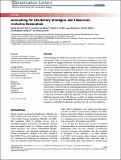Por favor, use este identificador para citar o enlazar a este item:
http://hdl.handle.net/10261/163465COMPARTIR / EXPORTAR:
 SHARE SHARE
 CORE
BASE CORE
BASE
|
|
| Visualizar otros formatos: MARC | Dublin Core | RDF | ORE | MODS | METS | DIDL | DATACITE | |

| Título: | Accounting for Life-History Strategies and Timescales in Marine Restoration |
Autor: | Montero-Serra, Ignasi CSIC ORCID CVN; Garrabou, Joaquim CSIC ORCID ; Doak, Daniel F.; Figuerola, Laura; Hereu, Bernat; Ledoux, J. B. CSIC ORCID; Linares, Cristina CSIC ORCID | Palabras clave: | Transplants Life-history tradeoffs Comparative demography Coral reefs Corallium rubrum Integral projection models Mediterranean Sea Restoration Octocorals |
Fecha de publicación: | ene-2018 | Editor: | Society for Conservation Biology | Citación: | Conservation Letters 11(1): e123241 (2018) | Resumen: | Understanding the drivers of restoration success is a central issue for marine conservation. Here, we explore the role of life‐history strategies of sessile marine species in shaping restoration outcomes and their associated timescales. A transplantation experiment for the extremely slow‐growing and threatened octocoral Corallium rubrum was highly successful over a relatively short term due to high survival and reproductive potential of the transplanted colonies. However, demographic projections predict that from 30 to 40 years may be required for fully functional C. rubrum populations to develop. More broadly, a comprehensive meta‐analysis revealed a negative correlation between survival after transplanting and growth rates among sessile species. As a result, simulated dynamics for a range of marine sessile invertebrates predict that longer recovery times are positively associated with survival rates. These results demonstrate a tradeoff between initial transplantation efforts and the speed of recovery. Transplantation of slow‐growing species will tend to require lower initial effort due to higher survival after transplanting, but the period required to fully recover habitat complexity will tend to be far longer. This study highlights the important role of life history as a driver of marine restoration outcomes and shows how demographic knowledge and modeling tools can help managers to anticipate the dynamics and timescales of restored populations | Descripción: | 9 pages, 5 figures, supporting information https://doi.org/10.1111/conl.12341 | Versión del editor: | https://doi.org/10.1111/conl.12341 | URI: | http://hdl.handle.net/10261/163465 | DOI: | 10.1111/conl.12341 | Identificadores: | issn: 1755-263X |
| Aparece en las colecciones: | (ICM) Artículos |
Ficheros en este ítem:
| Fichero | Descripción | Tamaño | Formato | |
|---|---|---|---|---|
| Montero-Serra_et_al_2018.pdf | 544,99 kB | Adobe PDF |  Visualizar/Abrir | |
| Montero_et_al_2018_supp_mat.docx | 530,74 kB | Microsoft Word XML | Visualizar/Abrir |
CORE Recommender
SCOPUSTM
Citations
46
checked on 06-abr-2024
WEB OF SCIENCETM
Citations
39
checked on 20-feb-2024
Page view(s)
442
checked on 18-abr-2024
Download(s)
386
checked on 18-abr-2024
Google ScholarTM
Check
Altmetric
Altmetric
Este item está licenciado bajo una Licencia Creative Commons

